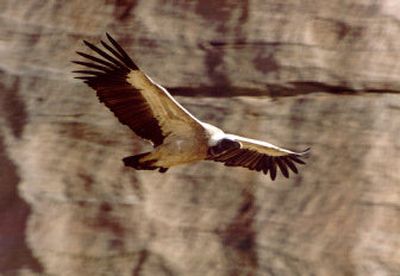Scientist finds root of Asian vulture deaths

Lindsay Oaks helped solve the mystery of the vanishing Asian vulture two years ago. But it took a while to get the killer off the streets.
Diclofenac, a drug used in cattle, was poisoning the birds on a massive scale, nearly wiping out three species over a decade.
But the drug is cheap and effective, and it took vulture proponents two years to win over India’s government, which recently banned the drug for veterinary uses. It’s still in use in Pakistan and Nepal.
“We’re hoping it’s not too late,” said Oaks, an assistant professor of veterinary medicine at Washington State University, who led the pathology work. “The scale and scope of it was completely unprecedented.”
Vultures occupy a symbolic place in the American imagination – movie scenes of the circling scavengers foretell death as surely as any image. In the Indian subcontinent, the birds are a very practical part of the ecosystem and the culture.
A lot of livestock there die of disease or natural causes, rather than at slaughter, largely because Hindus don’t eat beef. Without vultures, livestock carcasses pile up, breeding disease and fueling the growth of potentially rabid species such as wild dogs and rats.
“Basically, they are the disposal system,” Oaks said, “and it’s a great system.”
The discovery that a drug was poisoning the birds when they fed on cattle has larger implications, Oaks said. It is a clear sign that drugs and their byproducts can have unexpected consequences in the environment.
Americans use tons of drugs every year, from aspirin to emerging biotech drugs. Diclofenac is commonly used to treat rheumatoid arthritis in humans. Not all those drugs stay in people’s bodies.
“A substantial amount enters the environment,” Oaks said. “No one really understands the effects.”
Until the mid-1990s, millions of vultures filled the skies over southern Asia.
In addition to serving as “natural garbage collectors,” they’ve been cultural and religious symbols for generations, according to The Peregrine Fund, a Boise-based organization that’s led the effort to save the bird.
In one religious tradition, Zoroastrianism, the dead are devoured by vultures as part of their journey to the spiritual world. But the vulture declines are disrupting that practice.
No one has solid estimates of the bird’s populations before they started dying off, but it’s assumed to be in the millions.
“Nobody ever bothered to count them in the first place, because there were just so many,” said Rick Watson, director of international programs for The Peregrine Fund. “I would equate them to pigeons in New York City.”
Then they started dying off in huge numbers. In 2000, The Peregrine Fund hired Oaks to head up its scientific efforts to find out what was killing the birds. He traveled to the Punjab region of Pakistan and began studying the birds.
“It was very quickly obvious that they were dying of kidney failure,” he said. “But there’s a million different things that cause kidney failure.”
Oaks and his colleagues began to rule out causes, like disease or heavy metal pollution. They compiled a list of veterinary drugs that might be involved – since vultures ate domestic livestock almost exclusively, and since almost everyone in the region has at least a cow or two.
When they investigated diclofenac, Oaks said, they found a direct connection.
“Every bird that died of kidney failure had residue of diclofenac,” he said.
Researchers in India, meanwhile, were finding the same thing. Oaks published his research in the journal Nature in 2004.
But negotiating the dense Indian bureaucracy took time, and efforts in Pakistan and Nepal have yet to pay off, Watson said. He estimates that of the three vulture species affected, two of them have been reduced “97, 98, even 99 percent,” and the other one is “functionally extinct,” with too few birds to make a comeback.
Still, he said he was encouraged by the Indian government’s ban on the drug.
“It is thrilling,” Watson said. “We thought it should have happened 18 months ago, but it’s great that it’s happening now.”